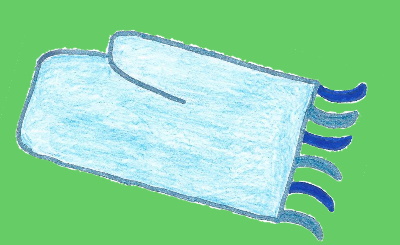 How to Play Mitaines
How to Play Mitaines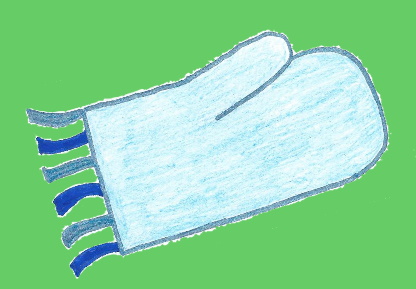
Mitaines is a unique Canadian card game designed for two or three players, with a
special four player variant described later in the variants section. This game is also known as Mittens or Mitts (the English
translation for the French word Mitaines).
Mitaines uses one standard 52 card deck. The cards in this deck rank slightly differently from the traditional ranking. This ranking is, from high to low; Jack, Ace, King, Queen, 10, 9, 8, 7, 6, 5, 4, 3, 2.
Determination of seating positions and first dealer can be performed in a variety of methods, with draw for high cards a common method. Using that method, each player draws a card from the face-down shuffled deck. Any players drawing equally ranked cards would discard those cards and draw again, continuing to re-draw until drawing a card that no other player has previously yet drawn. After all players have drawn unique cards, the players would then seat themselves at the table, in preference order from highest ranked card drawn to lowest. The player drawing the highest card of all is set as the first dealer. After each hand, the role of dealer rotates around the table in a clockwise direction from player to player.
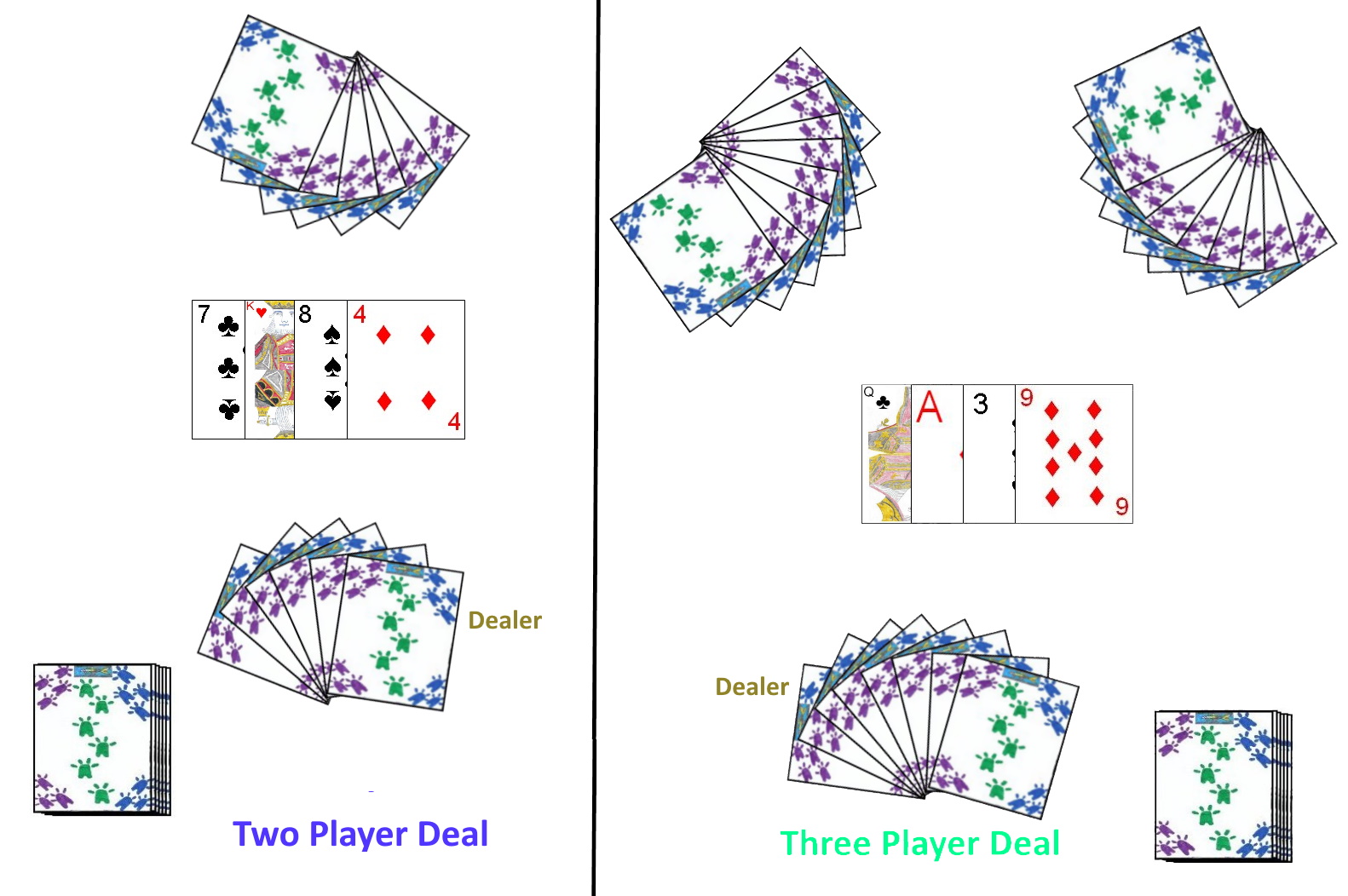 The number of cards dealt to each player is directly dependent on the number of players in the hand. The cards are usually dealt in face-down packets of cards in a clockwise direction around the table.
The number of cards dealt to each player is directly dependent on the number of players in the hand. The cards are usually dealt in face-down packets of cards in a clockwise direction around the table.
- For a two player game the dealer would first deal a face-down packet of three cards to his opponent, then two cards face-up to the discard pile and then a face-down packet of three cards to himself. He then repeats this same process, such that the discard pile contains four total face-up cards and each player has a total of six.
- For a three player game, the dealer would begin by first dealing a four card packet to each opponent in a clockwise direction starting with the player at his immediate left, then two face-up cards to the discard pile and then a three-card face-down packet to himself. He would then repeat this same procedure a second time such that each player has a total of eight face-down cards and the discard pile contains four cards.
The object of this game is to win the game by scoring the most points by the end of the game. This is done by capturing the ten of Diamonds as well as special card combinations called Mittens, Gloves and Socks.
The player to the immediate left of the dealer has the first turn, and the turns proceed around the table, from player to player, in a clockwise direction. On each turn a player will play one card remaining in his hand to the top of the discard pile. In certain cases, the card played may allow the player to clear the discard pile, and potentially capture certain cards within it. Player's can also make certain announcements as appropriate.
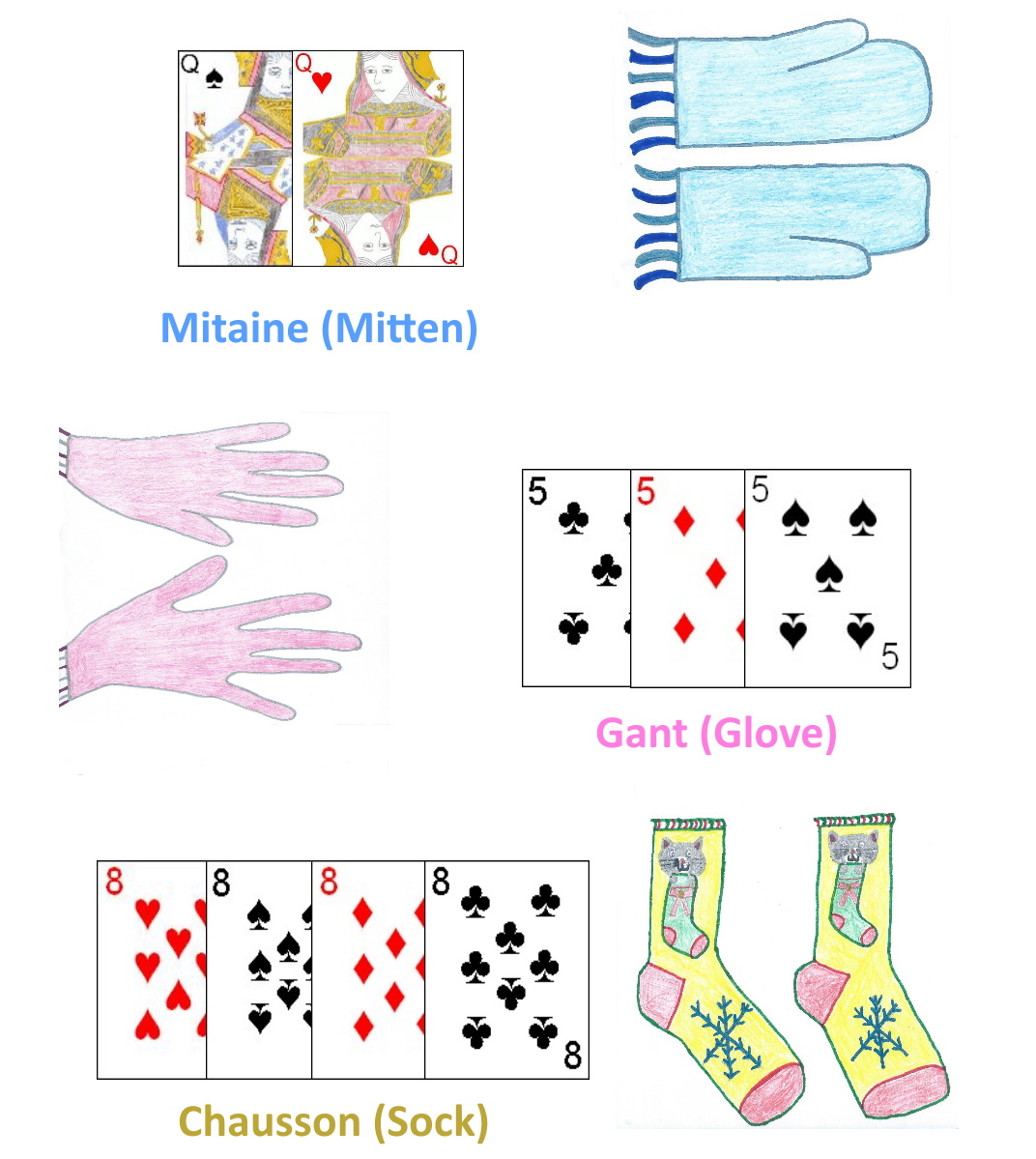 The most common method of scoring, and often the most lucrative, is the declaration and capture of special combinations of 2, 3 or 4 cards of the same denomination. Thus, a player may make a declaration of one of these special combinations on his turn, doing so when playing the first card of such a combination. An announcement of a two card combination is called a Mitten (or Mitaine), a three card combination is a Glove (Gant), and a four card combination is a Sock (Chausson). In making the announcement, the player indicates the type of combination (Mitten, Glove, or Sock) as well as the denomination of card in the combination. The player who holds the required number of cards
for that combination, may play the first card of the combination and then
make the appropriate announcement. Doing this also freezes the discard pile,
which only allows the discard pile to be captured by capture of the
announced combination or perhaps a higher ranking announcement and capture.
The most common method of scoring, and often the most lucrative, is the declaration and capture of special combinations of 2, 3 or 4 cards of the same denomination. Thus, a player may make a declaration of one of these special combinations on his turn, doing so when playing the first card of such a combination. An announcement of a two card combination is called a Mitten (or Mitaine), a three card combination is a Glove (Gant), and a four card combination is a Sock (Chausson). In making the announcement, the player indicates the type of combination (Mitten, Glove, or Sock) as well as the denomination of card in the combination. The player who holds the required number of cards
for that combination, may play the first card of the combination and then
make the appropriate announcement. Doing this also freezes the discard pile,
which only allows the discard pile to be captured by capture of the
announced combination or perhaps a higher ranking announcement and capture.
Once a player makes such an announcement, on each subsequent turn, he must play another card of that same denomination in an attempt to capture his declared "Mitten", "Glove" or "Sock". A player may never declare an announcement of a combination he does not actually have the capability to complete. Once he plays the last card of that denomination, completing the combination, he then clears the discard pile, also earning points (awarded at the end of the hand) in the process. Points earned can be immediately recorded on a score sheet or players can use some of the cards from the combination to help record the score during the hand (see scoring methods, further below). Cards cleared or captured from the discard pile are set aside, out of play (in the waste pile or a player's capture pile).
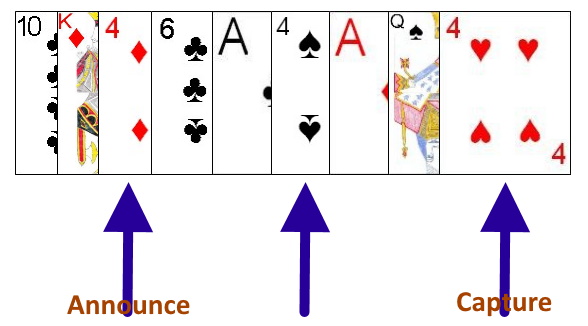 When a player announces a Mitten, Glove, or Sock, however they must be
careful, as another may be able to "steal" that player's combination by
announcing (and on a later turn, completing) a higher ranking combination. To be considered
higher ranking the announced combination must be a combination consisting
of more cards (i.e. a Glove outranks any Mitten) or the same combination
but consisting of higher ranking cards (i.e. a Mitten of nines would outrank a Mitten of
fives). When a player makes such an announcement, he must play the first card of that combination on his turn, at the same time as his announcement. Thus, once a player overcalls a higher ranking announcement, the prior announcement is no longer valid and can not be captured by the original player, even if he plays the appropriate cards to form that combination. However, any previously outranked combination can be overcalled, by another player, by a still higher combination, this continuing until some player finally manages to call (and complete) his higher combination. A player who manages to "steal" a previous combination in this way, if able to complete his own combination, is entitles to score not only for his own completed combination, but also for each previous combination that was previously declared by any other players (including himself) since the discard pile was last cleared by any player.
When a player announces a Mitten, Glove, or Sock, however they must be
careful, as another may be able to "steal" that player's combination by
announcing (and on a later turn, completing) a higher ranking combination. To be considered
higher ranking the announced combination must be a combination consisting
of more cards (i.e. a Glove outranks any Mitten) or the same combination
but consisting of higher ranking cards (i.e. a Mitten of nines would outrank a Mitten of
fives). When a player makes such an announcement, he must play the first card of that combination on his turn, at the same time as his announcement. Thus, once a player overcalls a higher ranking announcement, the prior announcement is no longer valid and can not be captured by the original player, even if he plays the appropriate cards to form that combination. However, any previously outranked combination can be overcalled, by another player, by a still higher combination, this continuing until some player finally manages to call (and complete) his higher combination. A player who manages to "steal" a previous combination in this way, if able to complete his own combination, is entitles to score not only for his own completed combination, but also for each previous combination that was previously declared by any other players (including himself) since the discard pile was last cleared by any player.
There is also a second method which a player can use to steal a Mitten or Sock. If a player on his turn is able to complete the Mitten or Glove previously announced by another player, he may do so (by playing the second or third card to the combination, as appropriate) which then then allows this player to capture that Mitten or Glove and score for it at the end of the hand. If the Mitten or Glove captured had overcalled a previous lower ranking Mitten or Glove, the player will score for those combinations as well.
Clearing the Discard Pile: In addition to clearing the discard pile with successful completion of the highest announced Mitten, Glove, or Sock, the discard pile can also be captured in a few other ways. First, if a player plays a card of the same rank as the current top card of the discard pile, this clears the discard pile. In addition, playing a Jack will also clear the discard pile. The discard pile may never be cleared by either of these methods however, if the pile is frozen due to any player having announced (but not yet captured) a Mitten, Glove or Sock. If clearing the discard pile in this manner, all the cards from the discard pile are set aside in the waste pile and the player usually earns no score, but can help prevent opponents from forming scoring combinations.
However, if the discard pile consists of exactly one card, and the current player in turn manages to play a card of the same denomination, he clears the pile, and scores 10 points (for a Mitten). This is sometimes called "Clearing for 10". If a player plays a Jack and the discard pile is currently empty (having immediately previous been cleared), the Jack does not clear the discard pile, and simply starts the new discard pile as it's first card.
Ten of Diamonds: The ten of diamonds is a special card and will earn bonus points for any player who manages to capture it. If any player manages to clear the discard pile on his turn (using any method) and that pile contains the 10 of diamonds, that player will earn 50 bonus points for capturing it. Note that in addition to being part of the discard pile when cleared by play of a duplicate card or a Jack, the 10 of diamonds could also be captured as part of a Mitten, Glove or Sock of 10's. In this case, the combination (Mitten, Glove, or Sock) is worth the usual scoring value, but in addition, a 50 point bonus is earned specifically for capturing the 10 of diamonds.
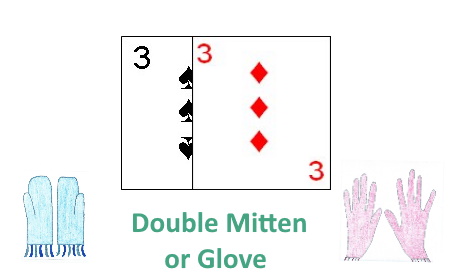 Double Mittens: A player can also, as the opportunity arises, score
for a Double Mitten. If the discard pile is empty, and a player on his turn
announces a Mitten of a specific rank, playing the first card of that (and
indicating he has another such card of that same rank), and the next player
in rotation,
on his turn, can complete the mitten with a card from his hand of the same
rank, he scores for two Mittens (called a Double Mitten) rather than just
one.
Double Mittens: A player can also, as the opportunity arises, score
for a Double Mitten. If the discard pile is empty, and a player on his turn
announces a Mitten of a specific rank, playing the first card of that (and
indicating he has another such card of that same rank), and the next player
in rotation,
on his turn, can complete the mitten with a card from his hand of the same
rank, he scores for two Mittens (called a Double Mitten) rather than just
one.Double Gloves: Similar to a Double Mitten, a player might also be able to capture a Double Glove. If the discard pile is empty, and a player plays the first card of a potential Glove (indicating he has three such cards of that rank), and the next player on his turn plays a card of that same rank (which would be the fourth card in that rank), this player scores the capture, earning the score for two Gloves (called a Double Glove).
Jacks: As mentioned previously, playing a Jack to the discard pile (when no Mitten, Glove or Sock) has yet been announced on this pile, immediately clears the pile. However, in addition to being able to clear the pile, a Jack might be used in form a Mitten, Glove or Sock completely of Jacks. If played to the pile in this manner, with the appropriate announcement, the Jack so played would not thus clear the discard pile, but will remain until captured as part of a Mitten, Glove or Sock (or stolen as part of a higher ranking combination by another player). In addition, if a Jack is played to the discard pile after a Mitten, Glove or Sock has been announced with the current discard pile by another player (of another rank), the Jack does not clear the discard pile and is simply played to the top of the discard pile as any other card. Mittens, Gloves, and Socks composed of Jacks have a higher scoring value than other Mittens, Gloves, and Socks.
Gameplay continues until each player has played the last card in his hand to the discard pile on his turn. If there are any cards remaining in the stock pile, the dealer deals each player a number of new cards (6 cards in a two player game and 8 cards in a three player game) but no new cards to the discard pile. Once the draw pile has been depleted and the players have played the last cards in the hand, scoring for the hand then occurs. The following chart shows all the possible scoring opportunities in this game:
|
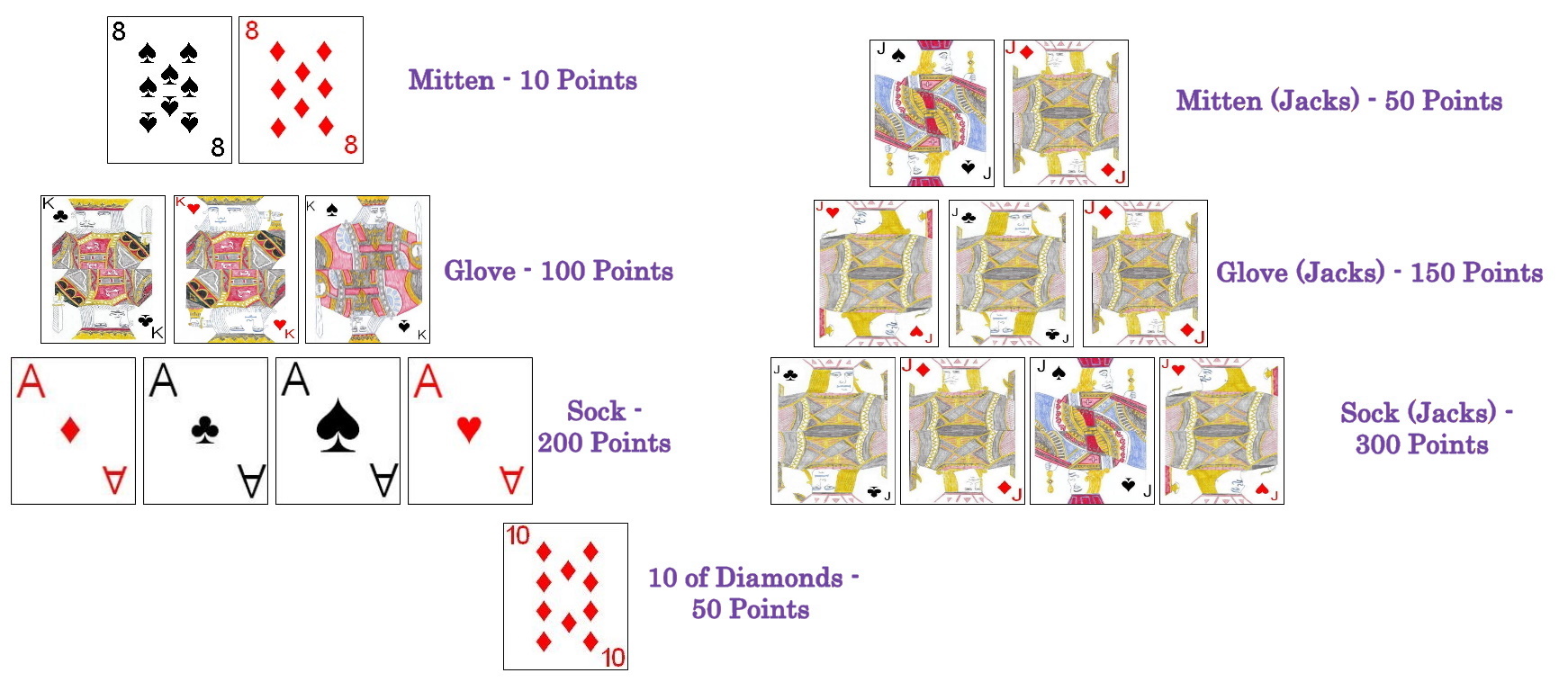 |
Keeping Score: As noted above, score can be kept on a score sheet immediately as the specific scoring events occur during the game. However, some players prefer to use another method in which one or more cards from the captured combination are retained by the player in a Capture pile designated for that player and then calculated for each player at the end of the hand. Thus, to use this scoring method:
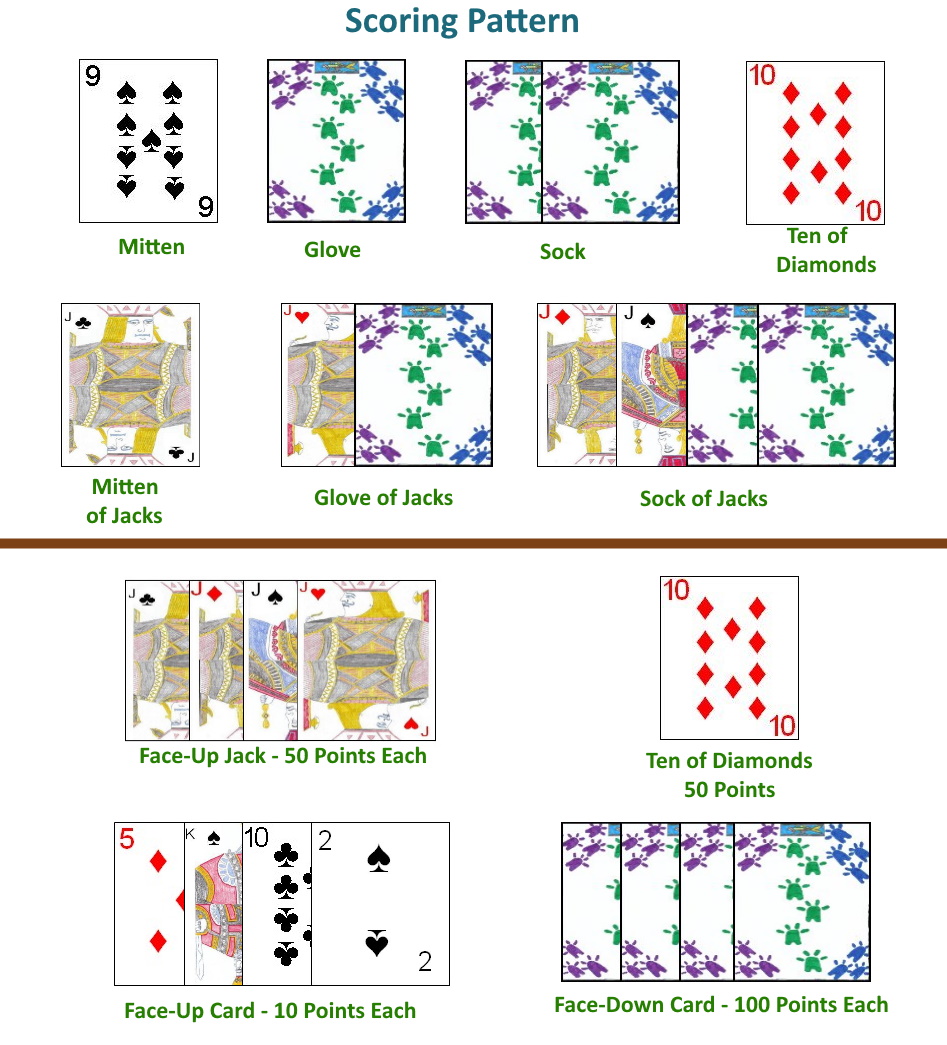
- For completing a Mitten, the player should take one of the cards used to form the Mitten, and place it face-up in his capture pile.
- If a player captures a Glove, he should signify this by taking one of the cards which was used to form the Glove and placing this card face-down in his capture pile.
- If a player manages to complete a Sock, he should retain two cards from that Sock in his capture pile, placing both cards face-down in his discard pile.
- If a player captures the 10 of diamonds from the discard pile, he should add this card to his capture pile, placing it face-up. If the 10 of diamonds was captured as part of a completed Mitten, Glove, or Sock, he should place add the 10 of diamonds to his capture pile face-up and then another card (or cards) from the combination to signify the appropriate combination captured.
- If a player manages to capture a Mitten of Jacks, he should place one of the Jacks from that combination in his capture pile face-up.
- If a player captures a Glove of Jacks, he should take two Jacks from the combination, placing one card face-down in his capture pile and the other card face-up.
- If a player manages to capture a Sock of Jacks, he should take two of the Jacks from the Sock and add them to his capture pile face-down and the remaining two cards from the Sock of Jacks and add them to his capture pile face-up.
- For Double Mittens and Double Gloves, the player scores double for the combination, so simply take double the number of indicated cards to signify the scoring combination, added to the player's capture pile.
- Each face-up Jack indicates a score of 50 points.
- The 10 of diamonds, face-up, indicates a score of 50 points.
- Each other face-up card indicates a score of 10 points.
- Each face-down card indicates a score of 100 points.
The game should continue over multiple hands, until one player reaches or exceeds 500 accumulated total points at the conclusion of a hand. If two or more players have a total of 500 or more at the end of any hand, the player with the highest such score is declared the game winner.